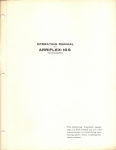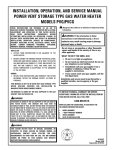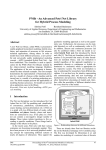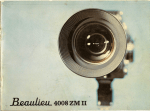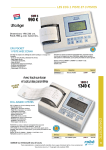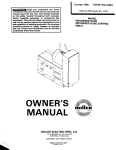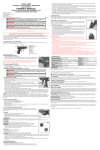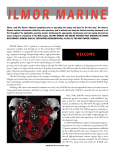Download ARRI Arricam System Operating instructions
Transcript
Arriflex 16S Operating Instructions 1 2 3 4 5 6 7 8 9 10 11 12 13 14 15 16 17 18 19 20 21 22 23 24 25 26 27 28 29 30 31 32 33 34 35 36 37 38 39 40 41 42 43 44 45 46 47 48 Film Magazine (200 ft.) Magazine Cover Lock Latch for Magazine Lock Camera Cover Lock Diopter Adjustment Ring Eyepiece Retaining Ring Lock for Diopter Adjustment Power Cable Lock Override Button for Buckle Switch Camera “ON” Switch Camera ”OFF” Switch Cover Lock Spring Magazine Opening Cover Tachometer Footage Counter Frame Counter Power Connector Viewfinder Cover Door Accessory Shoe Focusing Lever Contour Hand Grip Re-Set for Footage Counter Re-Set for Frame Counter Motor Lock Lever Variable Speed Motor Rheostat To Control Camera Speed Inching Knob Eyelet for Carrying Strap Knurled Dis, Camera Take-Up Locking Levers for Torque Motor Torque Motor Knurled Disc, Magazine Take-Up Film Supply Counter Forward/Reverse Switch for Torque Motor Knurled Disc, Magazine Supply Knurled Disc, Camera Supply Lens Turret Lens Retaining Lever Filter Stage, Rotating Filter Stage, Stationary Matte Slot Matte Box Matte Box Beam Lock Screw for Matte Box Lock Screw for Matte Box Stages Diaphragm Ring Turret-Rotating Grips Eyelet for Carrying Strap The Arriflex 16S/B-GS [With 60-Cycle Generator and Automatic Startmarker] The 16S /B-GS is a special model of the basic Arrilflex 16 S/B. It is factory equipped with a 60-cycle generator, an automatic startmarker and a manually operated cue marker, designed to work with all ¼” tape recorders equipped with the pilotone system. The 60-Cycle Signal Generator A miniature generator is built into the camera. When the camera runs at 24 fps, the generator ooutput is a 60-cycle signal of approximately 1.2 volts. This signal is the heart of all Piloton synchronizing systems. The output appears across pins 1 and 2 of the camera’s 5-pin Tuchel outlet, after a 300 milli-second delay. Sync cables are used to carry this signal to the tape recorder. (See price list for various types). Automatic Clapstick The 16 S/B-GS has an automatic startmarker capable of putting startmarks on the film and on the tape, automatically, each time the camera is started. The miniature lamp, which is visible just over the camera hand grip is paired with another lamp, located inside the camera. The inside lamp flashes whole frames of film, during camera run-up time. The result is that the beginning of each take, three or four frames of film are flashed. The start mark on the tape corresponds with the point just past the last flashed frame on the film. Light from the interior marking lamp in visible in the viewfinder, during run-up time. Note that the lamps are activated only when a properly wired cable is plugged into the 5-pin Tuchel outlet. To remove the start marking lamps for replacement, turn the plastic housing on its metal base counterclockwise. The pair of lamps are secured to the ends of the black rod (P1) which may be lifted out. These lamps are resistance matched pairs, and must always be replaced with a new, matched pair. 8 Volt DC Output At the same time, during which the start mark lamps are energized, the camera will supply 8 volts DC through pin 3 on the Tuchel outlet. (See schematic). This voltage energizes a 1000 cycle oscillator built into the tape recorder. The 1000 cycle signal is recorded on the tape and serves as a start-mark in the sound track. The oscillator is cut off simultaneously with the marking lamps in the camera. Therefore, the point where the 100 cycle signal ends on the tape, corresponds with the point where the flashed frames end on the film and constitute the sync point. Edge Marking System The edge-marking lamp is mounted in the base of the camera under the coin slotted contact screw. The mating indicator lamp for edge marking is located on top of the small generator casting on the right side of the camera. These lamps are also a matched pair and should be replaced with matched pairs. At the start of a take, the edge-marking lamps work simultaneously with the full frame marking lamps. However, these lamps mark the film at the edge only, and the edge marking is displace on the film by about 3 ½ frames from the aperture in direction of travel. The edge-marking lamp can be energized manually during a take for event marks of various kinds. Arriflex 16S Operating Instructions Each Arriflex 16 S/B is SUPPLIED WITH: 1 Test film taken with camera 2 Plastic skewer for cleaning emulsion from film gate. 3 Bottle with special camera oil 4 Tube of special grease for lens cavities of camera and lens mounts. 5 Pressure Oiler 6 Guarantee Card 7 Instruction Manual The shipping container in which the camera is supplies should be saved and used in case the camera has to be sent for service. NOTE: Numbers in ( ) refer to callouts on front overleaf. Holding the Camera Place thumb of right hand between contour grip (21) and side of camera, while the other fingers reach forward around the “bulge” so they are free to actuate the follow-focus grips (38) and diaphragm ring of the lens in taking position. Place palm of left hand around finder housing on left side of camera, fingers over ON-OFF switch this way, camera can be held steady and comfortably. When the “ON” switch (10) is pressed down, it remains locked in the downposition until the release lever (11) is pushed in. An accessory PISTOL GRIP WITH OR WITHOUT SHOULDER BRACE IS ALSO AVAILABLE. It is attached to the tripod socket in the base of the camea and has its own release trigger which activates a switch inside the tripod socket. Viewing Place eye against finder eyecup. (Eyeglass wearers should remove or raise glasses to forehead and sight without them). For left eye viewing, the eyecup can be rotated. A periscope finder can be used for left eye viewing when a magazine is attached to the camera. If viewing is obstructed by the closed mirroe shutter, turn the inching knob (27) on the motor to open the viewing system. First focus your eye to the ground glass or fiber screen by turning the knurled diopter adjustment ring (5) at the eyepiece until the grain structure of the ground glass appears sharp. You best do this without a lens in the turret socket. The adjustment ring (5) should then be secured with the diopter lock ring (7). This setting need never be changed unless other persons use the camera. Once proper finder focusing is obtained, you can focus on a subject by actuating the focusing mount of the lens. For critical sharpness, always focus the lens with its diaphragm wide open. While the optical system of the finder is constructed so that it prevents light from entering and fogging the film, the eyepiece must be shielded from direct (horizontal) sunlight or powerful back light when the eye is removed from the eyepiece. For this purpose a light cover (18) is provided inside the rubber eyecup. During filming always press eye firmly against eyecup or close the cover door (18) on the eyepiece. The automatic eyepiece, available as an option, will close the reflex finder system anytime pressure against the eyecup is removed. Detachable Eyepiece The detachable eyepiece, the same on all Arriflex cameras, permits the use of a variety of finder accessories like the PERISOPIC ACCESSORY FINDER, WHICH FACILITATES VIEWING FROM THE SIDE OR THE TOP (for instance if camera is on a microscope or copy stand), or viewing with the left eye when a 400 ft. MAGAZINE is attached to the camera. A finder extender can also be mounted when working in unusual situation. To remove the eyepiece, turn the knurled chrome-plated collar (6) clockwise. To re-mount it, first engage the keyed flange properly then turn the collar (6) counterclockwise. Exercise care not to cross thread the collar and make sure the eyepiece is flush against the finder flange. The rubber eyecup swivels freely in its ball-stop bearing and can be pulled off for cleaning. The installation of a prescription corrective lens – of 15.5mm diameter – is possible in a specially provided recess in the eyecup assembly. Ground Glasses/Fiber Screens The standard ground glass, supplied with the camera, is marked to show: center cross, TV safe action and camera aperture. It can be interchanged for a special ground glass with center cross and projector aperture only, or for a clear glass with reference reticle for cinemicroscopy. (See price list for details.) Such installations must be done only by skilled, Arriflex trained technicians and require special tools. All 16 S cameras equipped with APEC have the new fiber screen in place of a ground glass. The fiber screen has distinctly greater brilliance, which is especially noticeable in low light conditions or at small lens apertures. Fiber screens are available for later installation in any Arriflex 16S above serial number 8981. On Arriflex 16S cameras with Serial Number 6101 to 8980, exchangeability of the ground glass to fiber screen is possible by using a finder modernization kit (see price list for details). The Three Lens Divergent Turret The Arriflex 16 features a heavy-duty three-lens turret (37). The lenses are mounted in a divergent manner of 21o to prevent optical and mechanical interference between wide-angle and telephoto lenses. A turret lock prevents the turret from being turned unintentionally. To lock the turret, be sure the taking lens is precisely located by the turret detent mechanism, then turn the lock lever clockwise as far as it will go. (See illustration 6). To open the turret lock, turn th elever counterclockwise. Three turret grips (47) make it easy to rotate the selected lens into taking position. Always turn the turret by means of the grips, never by the lenses. The back of each turret grip (47) is coded with either one, two or three dots. These dots can be seen from the rear, while filming and can therefore be used to indicate if the wide angle, normal or telephoto lens is in taking position. Standard Lens Mounts Two of the three lens cavities are for standard Arriflex lens mounts. These are ideal for fixed focal length lenses or average size. To seat lenses in standard Arri mounts: Press the pair of lens locking levers (38) together, align the keyway in the lens mount with the key in the socket and carefully place the lens in the socket. When the lents is seated, release the lock levers, and check that the lens is locked safely in place. Always keep lens mount and lens socket lubricated with a trace of the instrument grease supplied with your camera. To remove standard Arri mounted lenses: Press the lens locking levers (38) together, then lift the lens straight out. Always keep empty lens cavities covered with cavity caps. Bayonet Lock Lens Mounts One of the three lens sockets is for lenses in Bayonet Lock Mounts. This stronger mount, is primarily intended for zoom lenses or other larger, heavier lenses. To seat Bayonet Lock Lenses: Note the locking lugs at the rear of the lens mount -position the lens so the lens data engravings are on the top, and the lugs are in line with the keyways in the socket. (See illustration). Insert the lens as far as it will go and then twist the entire lens clockwise by 15°. You will hear and feel the mount latch into place. The lens locking levers (38) operate automatically in this case and need not be depressed. To remove Bayonet Lock Lenses: Press the Locking Levers (38) together, rotate the lens counterclockwise. Then lift the lens out of the cavity. Always try to hold the lens on a fixed part of the barrel. Don't rotate the lens for mounting purposes by the focusing or iris rings. The Bayonet Lock mount provides seating and lens alignment of superior precision and durability. Use zoom lenses always in Arri Bayonet Lock Lens Mounts. Lenses for Arriflex are made by the world's leading optical manufacturers and represent the ultimate in optical and mechanical quality. Lenses available for the Arriflex 16 range in focal length from 5.7mm on up. Standard lenses are equipped with follow-focus grips (20) and most have diaphragm click-stops. Use only lenses in genuine Arriflex lens mounts to insure trouble-free operation and optimum image quality. For extremely long or heavy lenses, lens support systems of various types are available, the most practical of which is the standard ARRIFLEX bridge plate system. Standard Matte Box and Filter Holder To attach the matte box to the camera, slide the end of the boom into the special shoe (19) on the front of the camera housing. Lock it into position by turning the knurled (44) knob at the front of the boom. The rear stage of the matte box is adjustable to accommodate lenses of various lengths. The front is adjustable for optimum protection from side light and to prevent vignetting irrespective of lens focal length. SPECIAL EFFECT MATTES such as key holes, binoculars, etc. can be inserted into a slot in the front frame. Two filter stages accept rectangular 60x75mm and 60x100mm GLASS FILTERS, or ARRI FILTER HOLDERS with frame for 2" square gelatine or glass filters. One of the stages can be rotated for use with GRADUATED OR POLARIZING FILTERS. (For filter listing see separate filter price list). The rear opening of the matte box is threaded to accept a screw-in adapter ring for Series 8 mounted filters. Universal Matte Box The Universal Matte Box, especially designed for Zoom lenses also accommodates many standard and telephoto fixed focal length lenses. Features include adjustable front and rear standards, two filter stages, one of which may be rotated for polarizing filters. 3"x3", 75mmx100mm graduated filters, and 4"x4" filters can be used. Motors The 8 Volt VARIABLE SPEED MOTOR is generally standard equipment for 16S/B. All motors are interchangeable. By simply opening lock lever (24), the motor may be pulled out of the camera housing and replaced with any other motor such as -GOVERNOR CONTROLLED CONSTANT SPEED MOTOR, 110V 60 HZ SYNCHRONOUS MOTOR, ANIMATION MOTOR and UNIVERSAL CRYSTAL CONTROLLED MOTOR. When mounting a motor, care must be taken to line up the locating pin with the keyway in the camera and to insert the motor, all the way into the motor cavity to insure proper electrical contact. Variable Speed Motors By turning ribbed motor housing, a rheostat is actuated to regulate the speed of the motor. The figures around the motor shell are arbitrary, however, after some experience, they permit the operator to reset the camera quickly for any desired speed. (With, a full charged 8 Volt battery the rheostat will be set between 3 and 4 to give 24 fps. A knurled disc (see Illustration) marked "R"-"F" is located at the back of the variable speed motor. When turned all the way to "F" (click stop), the camera will run Forward; turned to "R" (clickstop), the camera will run in Reverse. When using a magazine, both, camera motor and magazine torque motor, must be set to run in the same direction, i.e. BOTH forward or BOTH reverse! The inching knob (27) in the center of the motor is used to turn the shutter and actuate the registration pin and film transport claw during the film loading operation. Constant Speed Motor The constant speed motor is used when only one single camera speed (24/25Fps) is required. In size and shape similar to the variable motor, the constant speed motor uses a centrifugal switch (governor) to keep the motor speed accurate within 1% under varying load and power conditions. The motor runs forward only and requires an 8V DC power source. Power Sources/Batteries Power requirements for Arriflex 16 with variable speed or constant speed motor and with 400 ft. magazine are: 8 Volts DC (under load); 3.6 Amperes running; starting surge up to 6 Amperes depending on ambient temperature and condition of equipment. For the crystal controlled motor, 12VDC is required. Be sure the magazine torque motor is a 12V version when using the crystal motor with 400 ft. magazine. (See special instructions.) Arriflex-made batteries are available in a wide variety of sizes, power output and connections. You may use any suitable power supply which is capable of delivering the required voltage and amperes. Generally, batteries with less than 1.8 Ampere/hours at rated voltage are not practical. In an emergency, the Arriflex 16S may be operated from a 6 Volt auto battery. Maximum camera speed will be approximately 24 FPS with the variable speed motor. A 12 Volt auto battery may generate excessive torque unless the battery is tapped for 8 Volts. MAKE CERTAIN PROPER POLARITY IS MAINTAINED. To use any Arriflex DC motor on 110 Volt AC current, a power supply with transformer and rectifier is necessary. (See 16S price list). Camera Tachometer & Film Counter The Arriflex 16S/B is equipped with a tachometer (14), which registers filming speeds from 5 to 50 frames per second. It registers forward speeds only. The camera should never be run above the maximum speed indicated by the tachometer. Below the tachometer are the film footage counter (15) and frame counter (16). Both can be zeroed easily by their respective setting discs (22/23). Film Gate The Arriflex film gate is extra long (3 inches) and has a full-length rear pressure pad with a side pressure rail. Cross stages around the picture frame both on the front and back plates prevent "film breathing". Made of stainless steel, tapped to high precision and wear chrome-plated, the Arriflex film gate is probably one of the most trouble-free yet highest quality film gates of any camera. It is important to clean the gate regularly of film emulsion and film base deposits. Never use any metal tools on the gate surfaces! Use only the plastic skewer supplied with the camera and a clean untreated optical cloth. Registration Pin With the film gate opened, the registration pin can be seen just above the transport claw. Its function is to locate the film precisely and to hold it in place during the moment of exposure. The registration pin ensures rock-steady pictures, a repetitively precise film line, and increased tolerance against film pitch changes. Never force the registration pin in any way while cleaning the gate, only activate it by turning the motor inching knob [27]. Film Transport Claw The film transport claw engages the film from the front, the emulsion side. Watch its action by turning the inching knob (27) and note that it engages the film while the registration pin is lifting out of the perforation. This way, during the entire frame cycle, there is always one claw engaged for positive control of film. Mirror Reflex Shutter The mirror reflex shutter is the heart of the Arriflex reflex system. It rotates at a 45° angle between lens and film plane and reflects to the ground glass of the viewfinder exactly the same image as is registered on the film. All of the light rays reach the film through the lens without any interference while the shutter is open, and are alternately reflected to the ground glass only while the shutter is closed. Thus the film, as well as the eye, always gets 100% of the light transmitted by the taking lens. The effective shutter opening is 180° and gives the following exposure times at various speeds: 8 FPS – 1/16 sec. 24 FPS – 1/48 sec. 12 FPS – 1/24 sec. 32 FPS – 1/64 sec. 16 FPS – 1/32 sec. 48 FPS – 1/96 sec. As this table indicates, the exposure can be calculated for the camera speed by doubling the FPS figure and reading the result as a fraction of a second (180° shutter only). Tripod Sockets Two tripod threads, one 1/4" and one 3/8" size, are provided in the bottom of camera housing. This socket is made of tool steel and is a replaceable insert in the aluminum camera housing. Many standard tripod screws might be too long and trigger the built-in switch for the pistol grip. An excessively long tripod screw could even damage the switch housing inside the camera. The standard length for tripod screw is 7mm = 0.280 inches. Camera Loading & Threading Turn cover lock (14) from “C” to “O” and lift cover. Lay cover down and be sure switch is in OFF position otherwise switch activating pin could get bent. Place 100 ft. film spool on upper spindle. Pull off about 2 feet of film. Both spindles have an automatic lock to hold film spool in place in any camera position. To take film spool out, push button in center of spindle and tilt camera sideways. Open film gate by pressing latching knob inwards and swing the pressure pad assembly open on its hinges. Before threading film, open pressure roller assembly A by pressing button B. Thread film around sprocket drum C. Swing off pressure roller 01, if necessary. Then arrest film by swinging back pressure roller D-1. Lead film to gate E by forming an upper loop according to marking in the camera body above the film gate. Register pin F must be in disengaged (up) position. If it is not, turn motor inching knob (27) until pin is lifted over the film guide. Place film into gate in such a way that a perforation hole engages the protruding film transport claw. Hold film down with two fingers, one at either end of the gate and turn inching knob (27) until the registration pin engages film and holds it in place. Be sure film lays flush down against the aperture plate, then close gate. Thread film around sprocket drum G, forming a lower loop according to the marking in the camera body below the gate, and close pressure roller D2, At this point the roller assembly A should be securely closed. The sprockets are designed to accept either single or double perforated film. It is important to set film properly by moving it back and forth with two fingers over each sprocket until you can feel that the sprocket teeth have engaged the perforations. Push the leading end of the film into the take-up slot of an empty 100 ft. daylight spool and secure it by a few turns. Place the spool on the take-up spindle and be sure it "'snaps" into place securely. The knurled spindle discs (28,36) outside of the camera serve to take up film slack by turning them in direction of the engraved arrows. When the film is running, these discs turn and indicate whether film goes forward or backward. When film has run off, the supply spindle stops turning thus indicating the end of the film in the event the buckle switch is not functioning. Prior to switching camera "ON" or closing the cover, move a few inches of film through gate by manually turning inching knob [27] clockwise. With camera connected to power, push down internal switch (K) and watch about 2 feet of film roll through the camera. (Note: A "100 ft. roll" of film on a daylight loading spool actually measures 106 feet to permit enough leader and trailer.) Then close camera and turn lock (4) to "C", Again, be sure that the door switch (10) is released, in the "OFF" position, otherwise the cover cannot be closed. Run off approximately 5 feet of light-struck leader before beginning filming. Set footage counter and frame counter to –0– by rotating the discs (22/23) next to the plexiglass windows. Buckle Switch With Manual Override The buckle switch (film end switch H) works properly only if the lower film loop is formed exactly according to the marking in camera body. When the end of the film has passed the film gate, the lower loop shortens, thereby pulling up the switch roller H, which in turn cuts off the camera motor. The camera can only be switched on again after the pressure roller assembly A has been opened and closed as described in the previous paragraph. The buckle switch also stays "OFF" in the event that the pressure roller assembly A is not closed properly, i.e., the camera will not start. Any shortening of the lower loop during the running of the camera actuates the buckle switch to prevent film jamming. Never actuate or force the switch roller H by hand! The buckle switch override button (9) underneath the finder tube permits the cameraman to circumvent the buckle switch circuit. On certain adverse and rare occasions, particularly due to heavy-duty shock or vibration, the micro switch of the buckle switch might trip and switch the camera off. With the override mechanism the cameraman can quickly restart the camera without opening the camera cover. However, when in doubt whether the buckle switch was unintentionally triggered by impacts or vibration, or whether it was actuated due to a film jam, it is recommended to open the camera, to check the film path and sacrifice a few inches of film rather than risk damage by just using the external override control. To do this, it is recommended that the cameraman push the override button and run the Camera just long enough to keep the end of the last exposed scene from becoming light struck when the camera door is opened. Then, stop the camera, open the camera door, check for and correct any malfunction, reset the buckle trip mechanism, reset the buckle override, (see following instructions), close the camera door, run-off light struck footage and continue. Finally, once the override (9) has been used, it will have to be reset so the buckle switch can be reactivated. To reset the override, the toggle lever U of the buckle switch override mechanism must be turned counterclockwise approximately 45° from its off position. This shuts off the override function. Magazine The top of the camera housing accepts the 400 ft. film magazine. A light-tight cover (13) protects the magazine slot. Before the magazine can be attached, remove the cover by pulling firmly on this latch (12). The camera housing is internally wired to supply power to the take-up motor. The contact is visible once the cover is pulled off. This power contact is silver-plated and must be kept clean at all times to insure lowest resistance. Arriflex 16S magazines are designed for 400 ft. and 200 ft. 16mm single or double perforated film on plastic core (darkroom loads) B-wound. By removing the core adapters, the 400 ft. magazine will also accept 200 ft. daylight loads on spools. Magazine Loading The following procedure must be done in total darkness when using core load film. To open magazine cover, depress the safety latch (leaf spring) and turn lock (2) counterclockwise to its stop. Swing supply guide arm up until it is arrested near top casting of magazine. With leading end of film unwinding clockwise, place roll on left spindle by pushing plastic film core onto core adapter. Do not "dish" the film by pushing down on the outer diameter of the roll! Unlatch supply guide arm and be sure the flanges of the roller slip over the film edges and guide it properly. Now slip the leading end of the film through the left hand slot between the light trap rollers until it exists on the outside of the magazine throat. Then reverse this procedure and push the film back into the compartment by feeding it through the take-up slot which is on the other side of the throat from where the film exited. Once back in the compartment, arrest the take-up guide arm in it's latch near the top of the magazine casting. Attach the film to the collapsible core by slipping it into the gap and locking it with the chromed expansion clip. During unloading, when using a collapsible center core, the film can easily unspool from the center unless it is deliberately held. It is recommended that a plastic core be inserted before repacking the film for the lab. By twisting the plastic core a few turns in the direction of the film wind it will "grab" the trailing end of the film and hold securely. Collapsible Core Standard Core Core Adapter Each one of the core adapters is easily interchangeable by depressing the buttons at the ends of the film spindles. A standard core adapter can be substituted for the collapsible one on the take-up side. In this case, a regular plastic film core would have to be used on the take-up side as well. Once the film loading procedure is completed, close the magazine by engaging the two location prongs on the bottom of the cover in the corresponding grooves of the magazine casting. Then lay the cover flush against the magazine and turn the lock clockwise until the safety latch "clicks" into position. Important Points To Check Attach the film on the supply and take-up cores so it will run freely without "wobble" inside the guide arm rollers. Be sure to release both guide arms before closing the magazine cover. The supply guide arm activates the film supply counter on the outside of the magazine! If not released, the counter will not indicate. Wind sufficient film onto the take-up core to be certain It won't slip, that it will wind even and in line with the guide roller. Always be sure to remove the core adapter from the exposed roll before repacking film for the lab. Many adapters have been lost this way. Practice the Ioading with outdated film, in the light, a few times and these procedures will quickly become routine. The Arriflex 16S has the sprocket drive in the camera compartment. To load the camera with a pre-Ioaded magazine, proceed as follows: Pull enough film out of the throat of the magazine so you can guide it through the magazine opening on the camera casting. Then engage the dovetail wedge on the rear of the magazine in the corresponding wedge on the camera, lift the magazine lock (3) which contracts the locking wedges and lower the front wedge into the camera casting. With the magazine loosely seated in the camera casting, pull the latch (3) of the magazine lock down and the resulting expansion of the wedges will secure the magazine to the camera. To prevent an accidental releasing of the lock, always hook the safety catch into the lock latch. With the magazine safely mounted on the camera, proceed with the film loading in the same manner as described previously for 100 ft. camera loads. Torque Motor The magazine take-up motor, torque motor, attaches to the body of the magazine by means of two lock levers (30) and becomes an integral part of it. To attach the torque motor to the magazine, both levers (30) are turned upward, the motor is pressed against the corresponding area of the magazine and then both levers (30) are turned in direction of the arrows until they are reasonably tight. In the center of the torque motor casting is the lever (34) which controls the forward/reverse running of the magazine. It is important that the setting of this lever corresponds with the directional setting of the camera drive motor. Prior to filming with a freshly loaded magazine always turn the two knurled knobs (32,35) on the torque motor in the directions indicated by the arrows to remove excessive film slack in the magazine. All later model torque motors are equipped with a grounding plug for a small wire, which leads directly from the negative pole of the battery cable to the torque motor. The most probable cause of torque motor failure is the lack of sufficiently good ground contact and the use of this wire is recommended at all times. Older torque motors can be retrofitted with this feature. Servicing and Maintenance The Arriflex 16S is built with utmost precision and is famous for its ruggedness. It will give absolute satisfaction if treated as any precision instrument should be treated, and if serviced at regular intervals, consistent with the amount of use, and the following recommendations. The most important rule is: KEEP THE CAMERA SPOTLESSLY CLEAN – INSIDE AND OUT! Particular attention must be given to the film gate. It is precision-lapped and chrome-plated to minimize film emulsion to settle. However, some emulsion deposit is inevitable and will vary with the type of film used, the relative humidity and other factors. The film gate should be checked and cleaned every 400 ft. roll and it should be carefully inspected and thoroughly cleaned at the end of each day's filming. Remove emulsion deposit with the plastic skewer supplied with the camera (NEVER METAL). If emulsion is hardened on film gate, remove it with a Q-tip dipped in acetone or alcohol. Be careful not to get any solvent on any optical surface. Acetone will also dissolve paint. After cleaning, polish gently with chamois or other soft, clean optical cloth. From time to time, the lens mounts and the three lens sockets in the turret should be cleaned to remove dirt and dust. After such cleaning, re-lubricate lightly with the special grease supplied with the camera. The standard lubricants used with the Arriflex are suitable for use in temperatures down to -20°C, provided the camera is in good working condition, and the lubricants in the camera mechanism itself are clean and uncontaminated by dirt. On special request and for extra charge, Arriflex cameras can be winterized at our Service Department to function at still lower temperatures. For details, consult section on "low temperature operation." Lubrication Your camera has been properly lubricated at the factory and is ready for operation. Do not oil before using unless camera had been stored and not been used for more than 12 months. After each run of 30,000- 50,000 feet of film through the camera, camera should be lightly oiled at two oil valves marked with arrows (one near the film gate, and one near the supply spindle). Only use the ball and pressure oiler supplied with your camera and the special oil contained therein. Do not overoil -too much oiling is as bad as too little! By observing the following "DON'Ts” you will protect the continued safe and reliable operation of your Arriflex: DON'T run camera without film at high speeds. DON'T attempt to disassemble any part of the camera. This should be done by factory-trained personnel only. DON'T touch mirror shutter with fingers. Clean it only with soft camel hair brush. In any case, a spot on the mirror does not affect the picture. DON'T exchange covers of different camera (serial numbers are engraved on each coyer and camera). DON'T use old or shrunk film; the registration pin's stroke is adjusted to the perforation pitch of fresh film (0.2994) according to ASA specifications. DON'T allow cameras to be serviced by unqualified service shops. Arriflex cameras require special knowledge and experience. DON'T neglect to have your camera serviced after approximately every 200,000 ft., or every two years, whichever comes first. Service should be more frequent under adverse conditions. Our Service Department welcomes your inquiries and is anxious to help you with any problem or unforeseen requirements you might have.






















